Back in the old days — I’m talking 1985 — mounting and using optical sights on an AR15 was problematic. The optics had to be mounted on some kind of contraption screwed to the carrying handle and sat so high you had to “cheek” the stock against your chin.
At first, I carried a Bushnell 3x9 scope on my AR15 and learned a lesson the first few times I pointed the rifle at human targets... even 3x magnification is too much when the distance-to-target is measured in feet.
So, the scope rode in my briefcase in case I needed to mount it for a long shot.
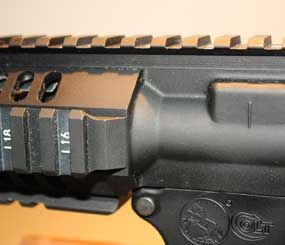 I’m using a Colt 5.56mm Advanced Law Enforcement Carbine (ALEC) as a test rifle, and its monolithic receiver extends the Picatinny mounting rail several inches farther forward, opening up several mounting options. (PoliceOne Image) |
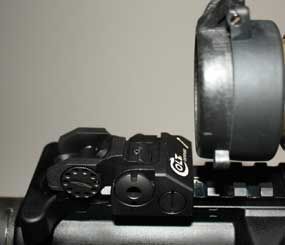 A rifle with an extended mounting rail allows the scope to be position far enough forward to allow a “nose on the charging handle” firing technique. (PoliceOne Image) |
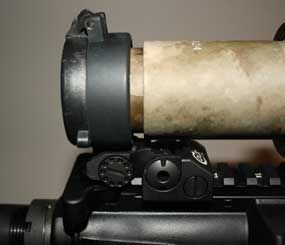 Standard flat-top receivers and cantilever mounts position the scope further aft, requiring a cheek weld well back on the stock for proper eye relief. (PoliceOne Image) |
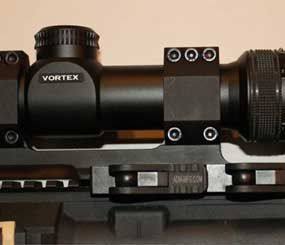 Made for Vortex by American Defense, this double-lever mount is a good choice if you plan to mount/dismount your optics frequently. (PoliceOne Image) |
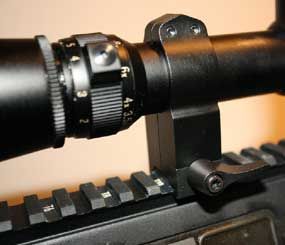 Warne QD rings are solid, hand dismountable/remountable and reasonably priced. (PoliceOne Image) |
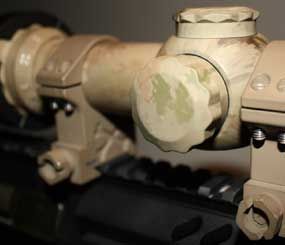 The Talley Manufacturing tactical rings in flat dark earth finish (scope is a Millett DMS 1-4x with ATAC finish), some of the most rugged and precisely made rings I’ve encountered. (PoliceOne Image) |
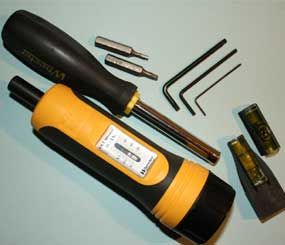 The “Fat wrench” and scope levels from Wheeler Engineering help you do a professional mounting job. (PoliceOne Image) |
Today’s flat-topped receivers are designed specifically for mounting optical sighting devices, most commonly 1x long-eye-relief designs using a red dot or holographic reticle perfectly suited for close, fast work.
I have written about the need for a few officers to expand their capabilities with magnified optics, filling the Designated Marksman (DM) role.
My summer project is to test as many DM scopes as I can locate and report my findings in a shopper’s guide later this year. Along with the scopes, I’m reviewing some great mounts as well and thought I would preface the scope article with a quick review of mounts and mounting techniques.
With a standard flat-top carbine using “conventional” handguards your scope mounting options are limited.
I’m using a Colt 5.56mm Advanced Law Enforcement Carbine (ALEC) as a test rifle, and its monolithic receiver extends the Picatinny mounting rail several inches farther forward, opening up several mounting options.
With a standard receiver, you’ll need a cantilevered mount system that moves the scope 2-3 inches farther forward and, with standard four-inch eye relief scopes, you’ll still need to slide your head well aft to get a proper image.
If you were taught to shoot an AR with your nose against the charging handle, like I was, you’ll find that impossible with most scope/mount combinations. With an extended Picatinny rail, you can mount scopes far enough forward to get proper eye relief with your nose against the charging handle, using the same shooting technique with either optics or sights.
I still remember the day I fumbled with dismounting the 3x9 scope on my old AR15 so I could deal with a bad guy holding a lady hostage — with a .357 revolver to her head — in an apartment doorway I knew would be less than seven yards away when I cleared a retaining wall.
So, while I do not require a guaranteed return-to-zero Quick Detachable (QD) optics mount system on a patrol rifle, I do insist on a mount that can be quickly removed to access the Back-Up Iron Sights (BUIS).
If you wreck a scope in a fall or other mishap, you MUST be able to access your BUIS to stay on mission.
In the photos you will see an excellent dual-lever QD mount supplied by Vortex optics with their Viper PST 1-4x scope, made for them by American Defense.
LaRue Tactical is considered by many to be the “Cadillac” of QD mounts for a flat-top rifle, but when properly set up and torqued, there are several top contenders.
You should expect to pay $200+ for a quality QD cantilever mount.
An excellent alternative for those with extended mounting rails are simple QD mounting rings from Warne Scope Mounts.
The Ultra High versions of their Maxima rings get most scopes high enough to clear most BUIS models. Warne’s QD rings come in either steel or lightweight aluminum versions and the price is very reasonable. They also have a line of fixed “tactical” rings which are wider for more grip area on the scope tube, at a higher price point.
I have Maxima steel ring sets for both one-inch and 30mm tubes and they have proven to be very rugged and reliable, needing nothing more than heavy thumb pressure to tighten or loosen the QD levers and return to zero. A set of Warne QD rings will set you back less than $100.
Another ring set I’ve been using during my testing is made by Talley Manufacturing. Talley makes a set of tactical rings for a flat-top AR which don’t appear yet on their web page, and these rings might just be the most precise and tank-tough mounts I’ve ever used.
Talley sent me a set of 30mm aluminum tactical rings that feature precision machined, square bottom lugs that mate with the slots on the Pictinny rail. The lugs engage two slots per ring, and fit so snugly they must be eased into position– no wobble with these even before you torque down the ½ inch nuts.
When I first saw the Talley rings at the NRA annual convention, I said the rings didn’t meet my criteria of being quickly removable in the field without needing tools. Their rep reached in his pocket, pulled out a quarter and loosened the coin-slotted heavy-duty nuts with hand pressure alone. OK, I’ll broaden my standards enough to require a quarter (or small swiss army knife blade) to loosen the mounts. I’ve torqued the nuts onto the mounting rail to their recommended 35 inch-pounds and still been able to loosen them with a quarter.
These rings retail for about $285 but are truly awesome.
Mounting optics on your AR is not rocket science, but having a little training and the right tools will pay off in a professional job. You will need a good exchangeable-tip screwdriver with the appropriate bits. Most quality mounts use either allen or torx-head screws. Using a torque wrench helps ensure screws won’t work loose or damage the rifle from too much pressure. The “Fat Wrench” in the photo is an adjustable model from Wheeler Engineering, or several scope/mount manufacturers sell fixed-setting torque wrenches for their recommended level of tightening.
Getting crosshairs square was always a pain for me until I bought leveling tools, also from Wheeler. I put the rifle in a padded vise (a bipod can do the same job) and level the top of the Picatinny rail. Then, when snugging the mount screws down on a scope, I set the level on top of the elevation turret cap and level the scope, it couldn’t be easier. I used to religiously use a thread-locking compound on all the mount’s screws, but doing so makes the screws damn hard to break loose. Most manufacturers now recommend the screws simply be degreased and properly torqued, without the need for thread lockers.
The scopes I’m reviewing all fall into the 1-4x or 1-6x magnification range, with illuminated reticles. I want them to start as close to true 1x as possible for CQB use. You never know when you might face a hostage holder at a few yards. Being able to magnify the image at least 4x will help with precision shooting. But even more importantly, the magnification will help you identify the threat posed by your adversary — target discrimination is perhaps the most important role of a Designated Marksman scope.
If you have an optic you would particularly like me to review, let me know. I have set my upper price point at about $1,500, figuring few officers/agencies can afford much more. So, the true works-of-optical-art devices like the Leupold 1.1-8x CQBSS (street price >$3,800) and the Schmidt & Bender 1.1-4x Short Dot (street price >$2,500) are off the table … only top-tier military teams and the most flush police officers/agencies are likely to sport one on their patrol rifle.


